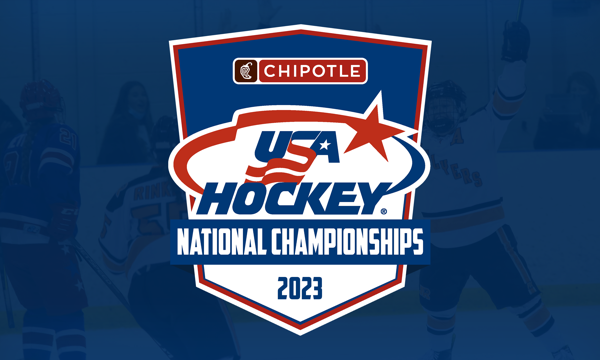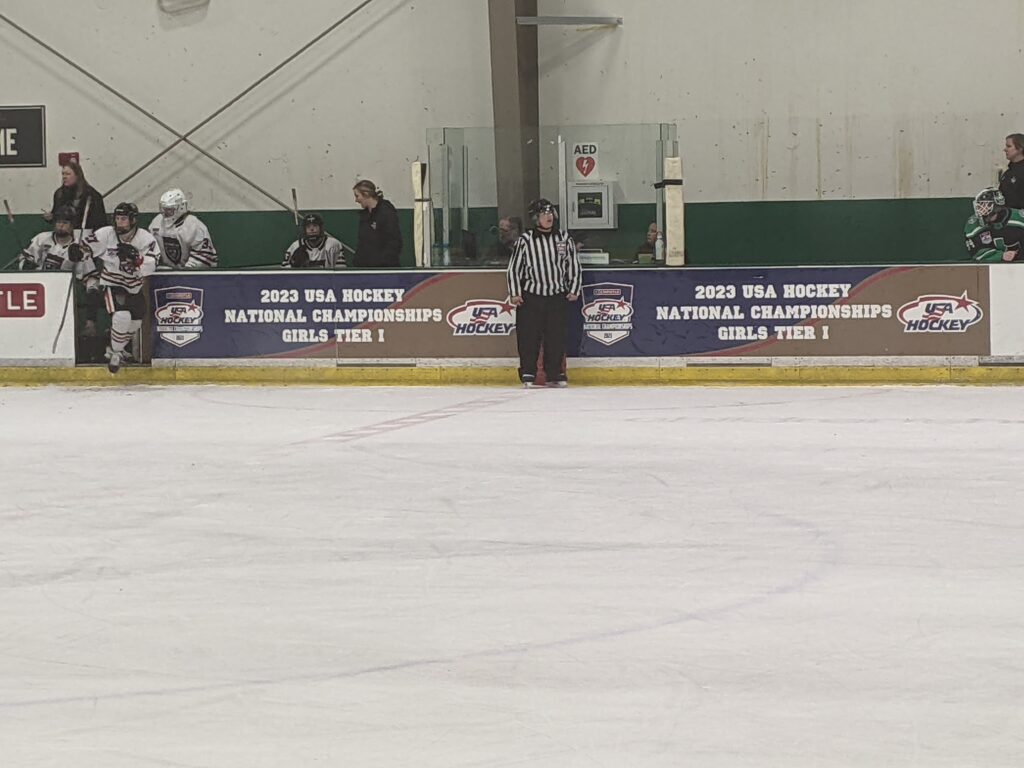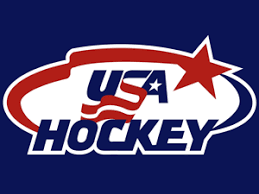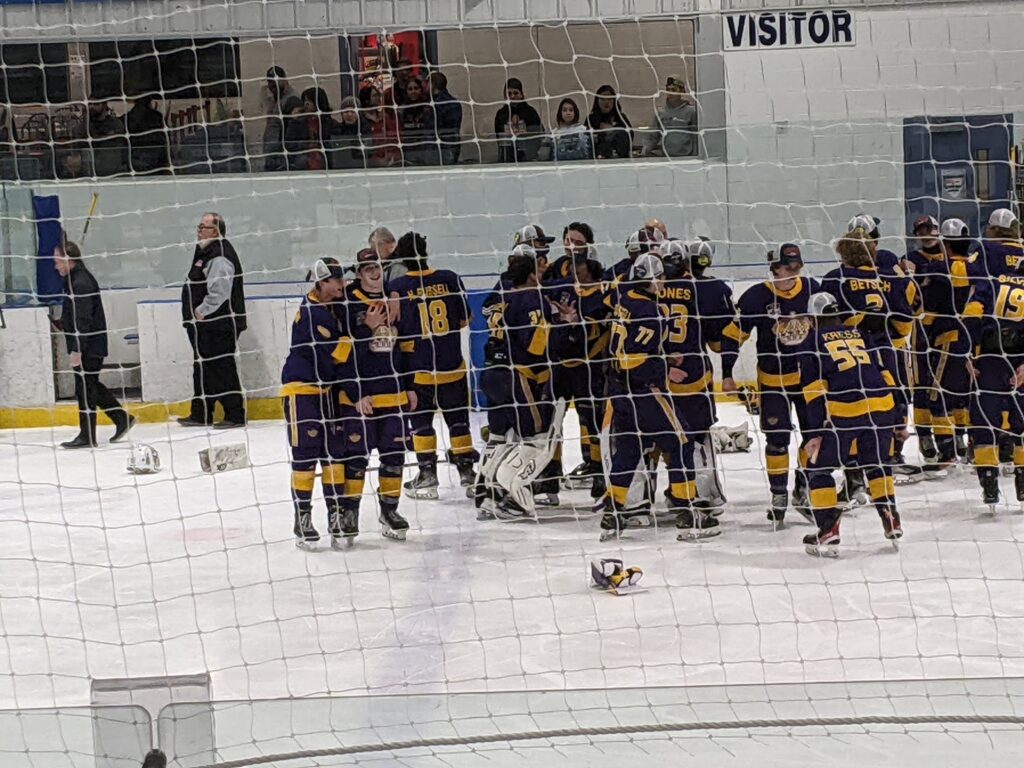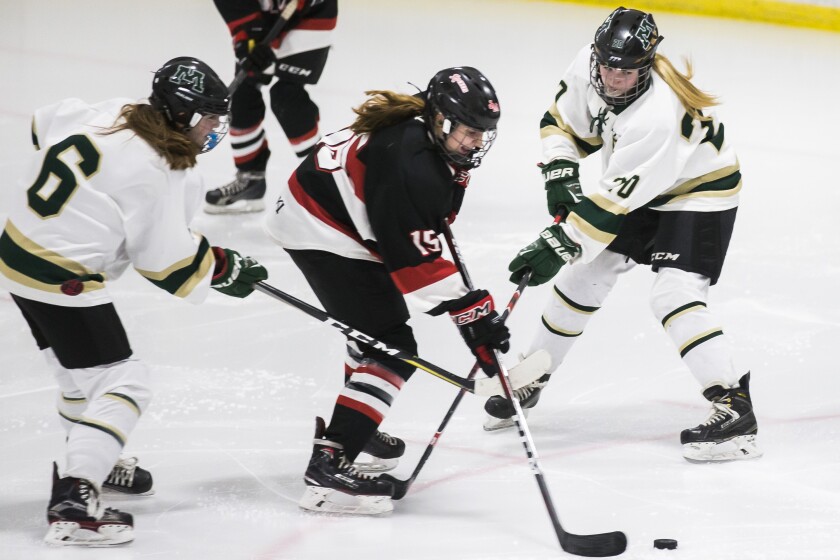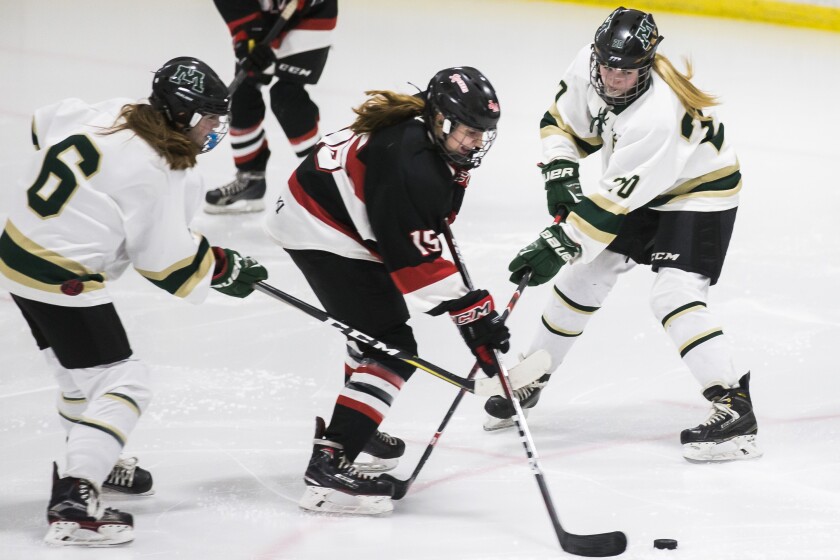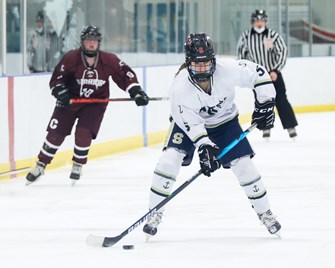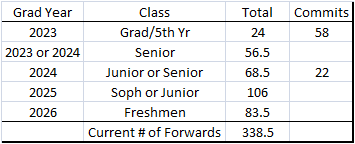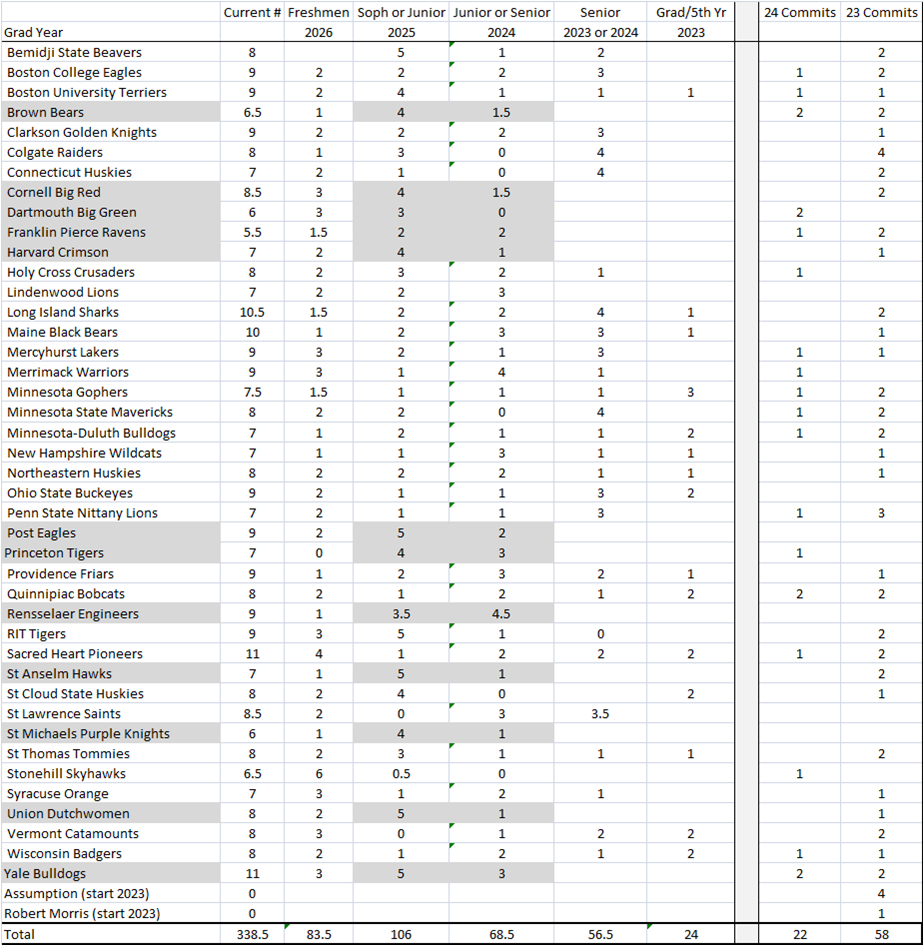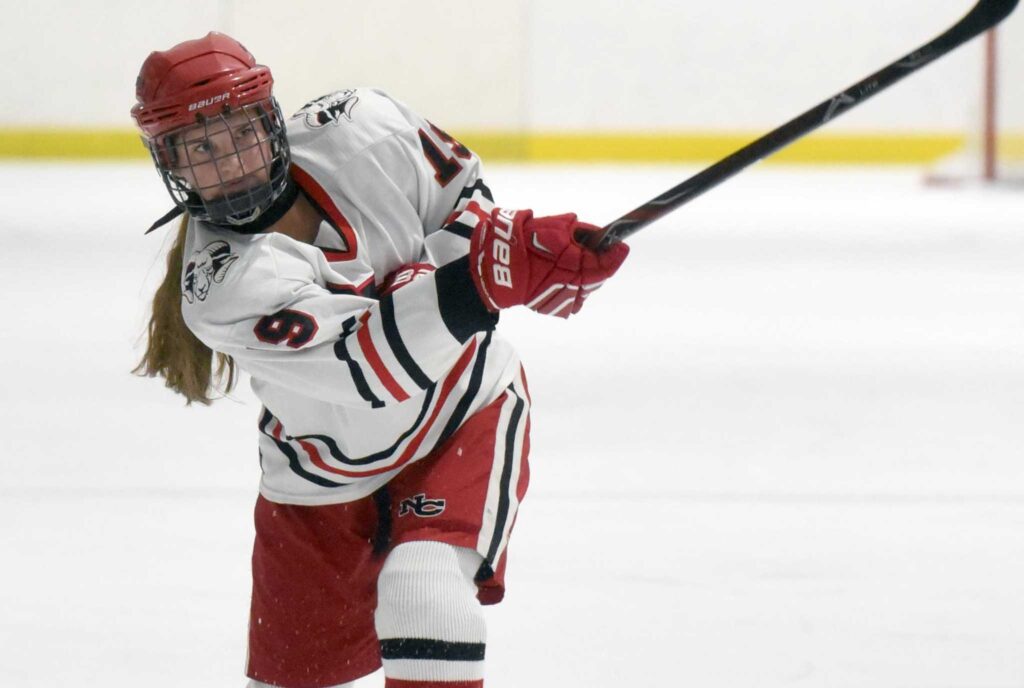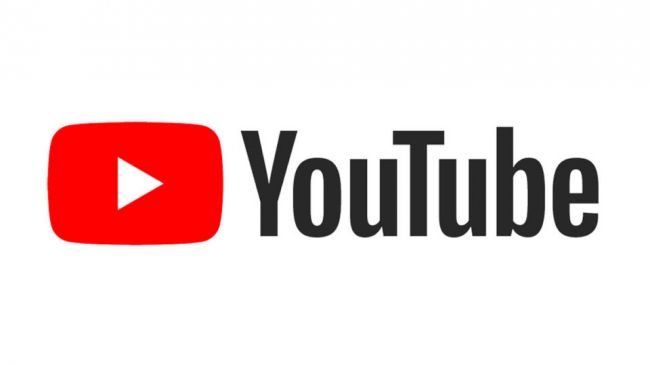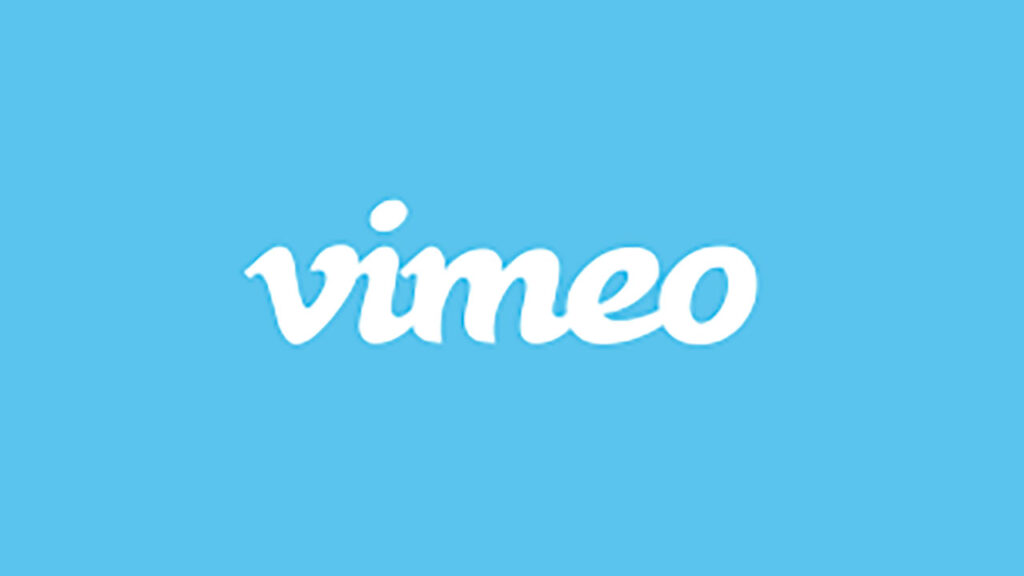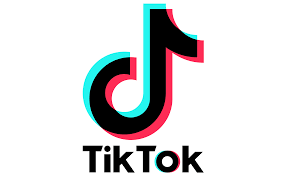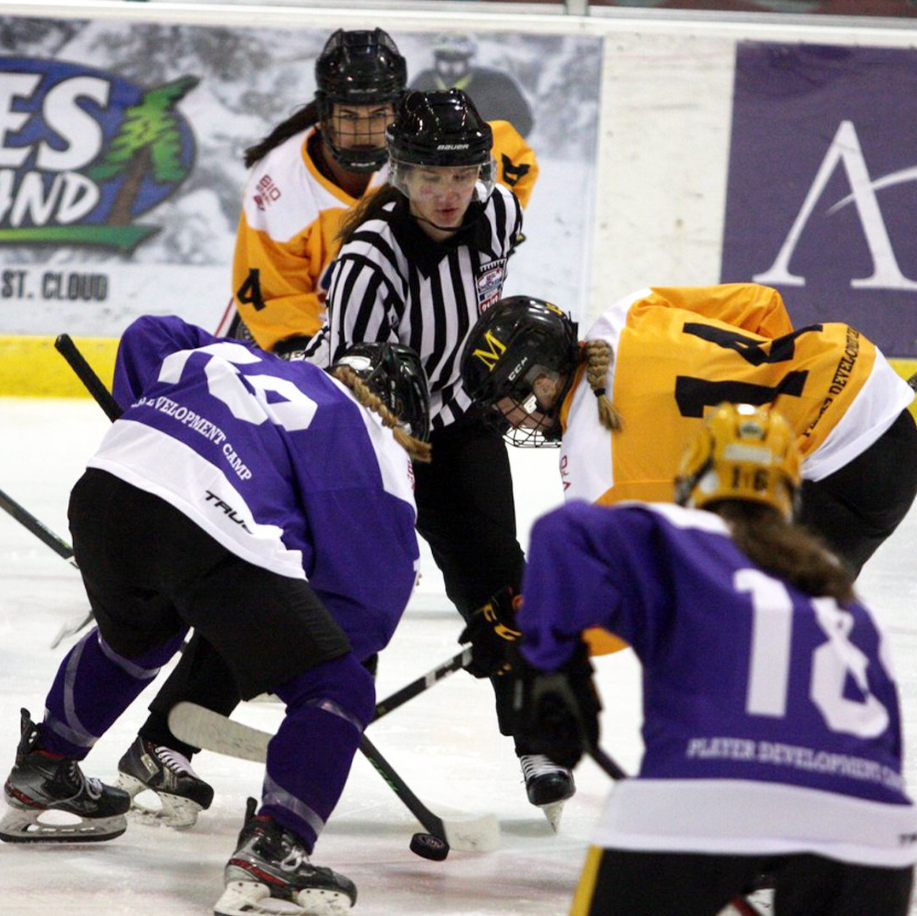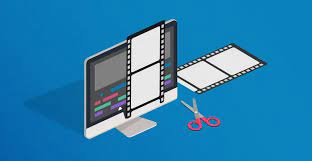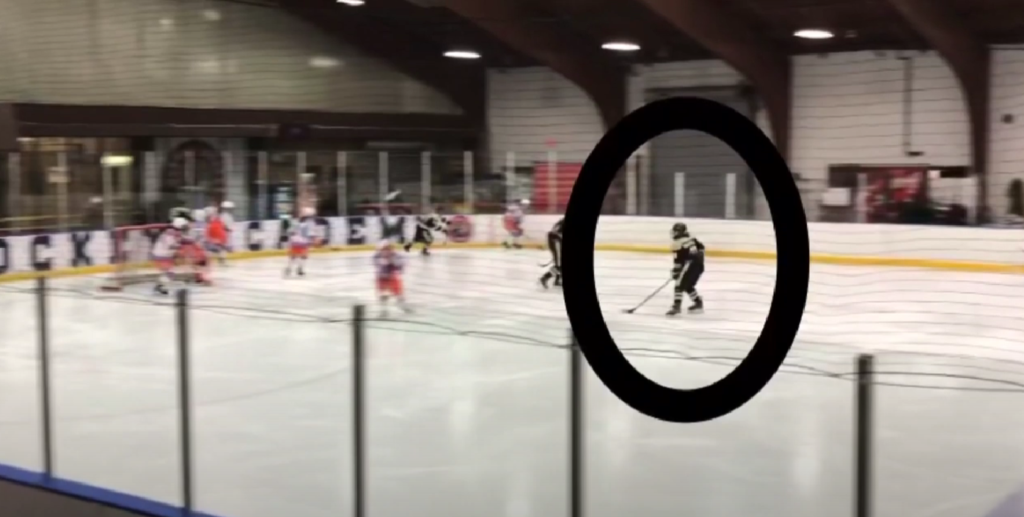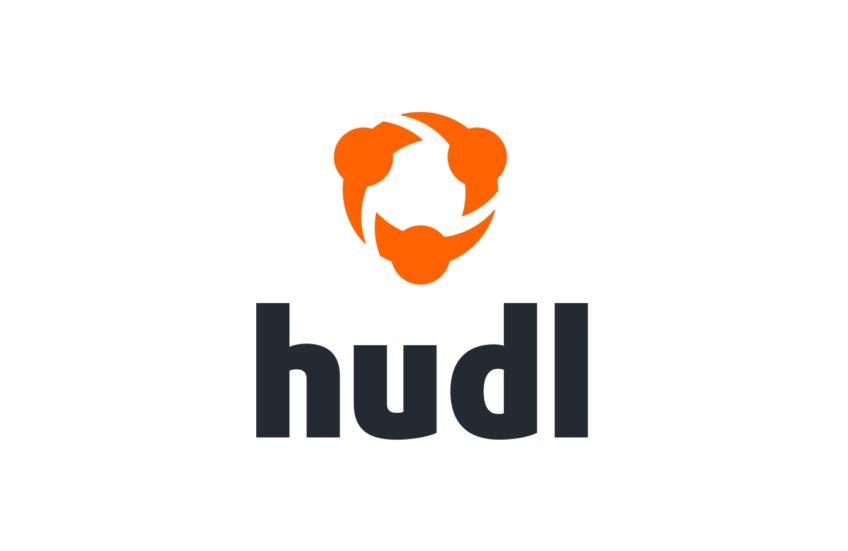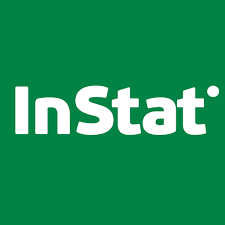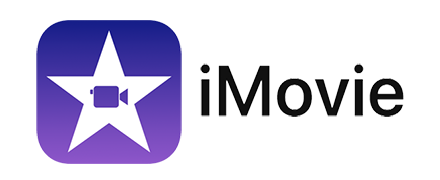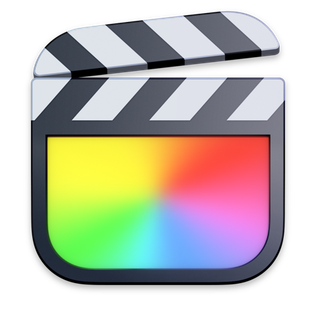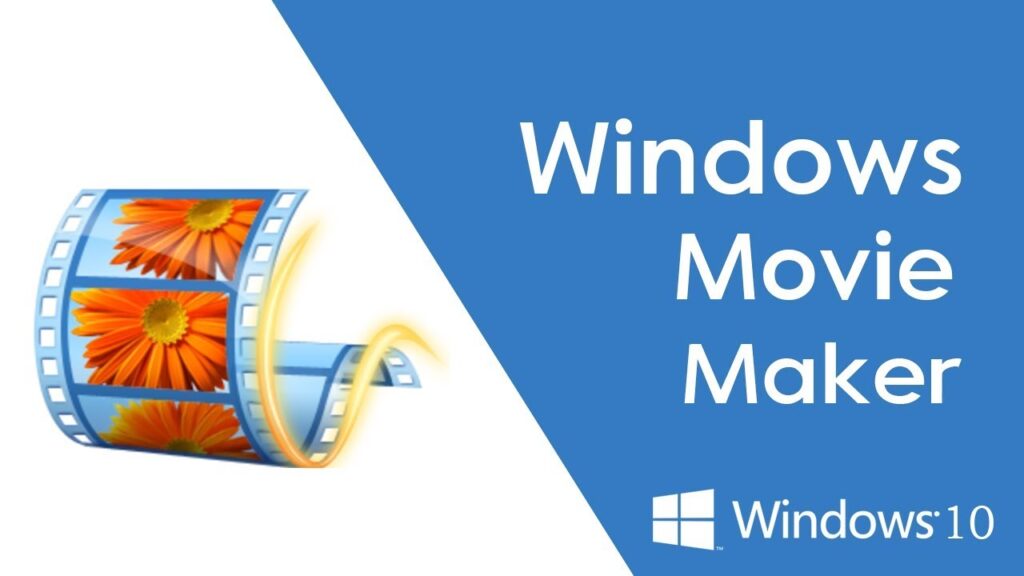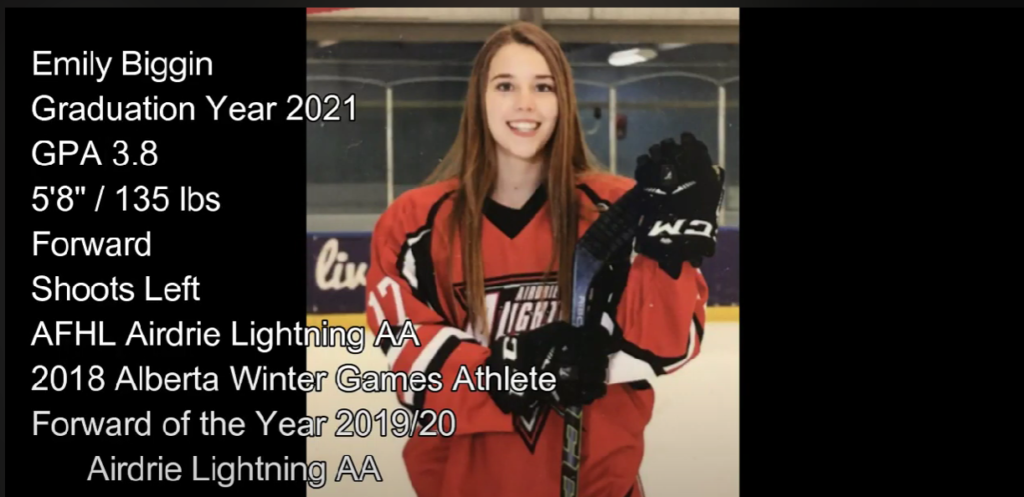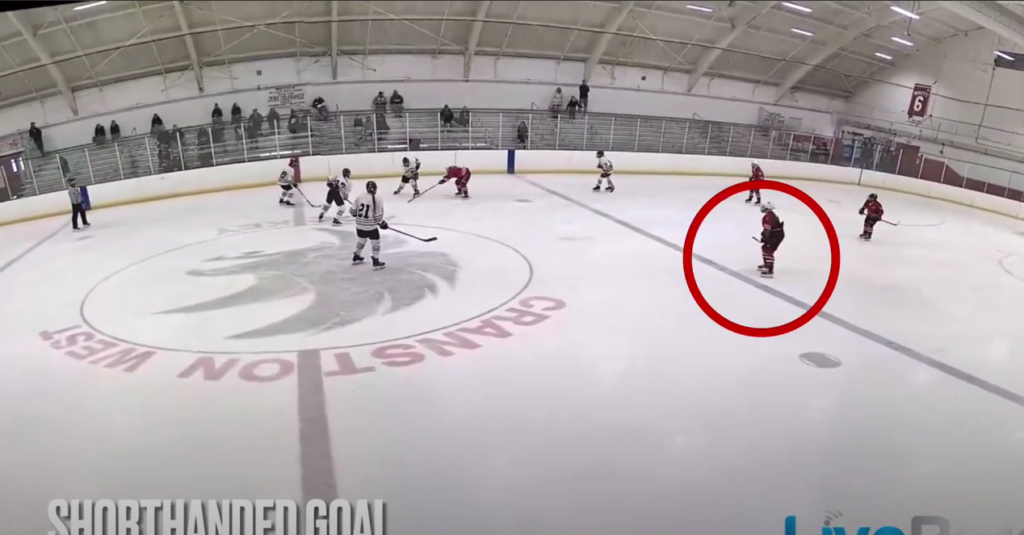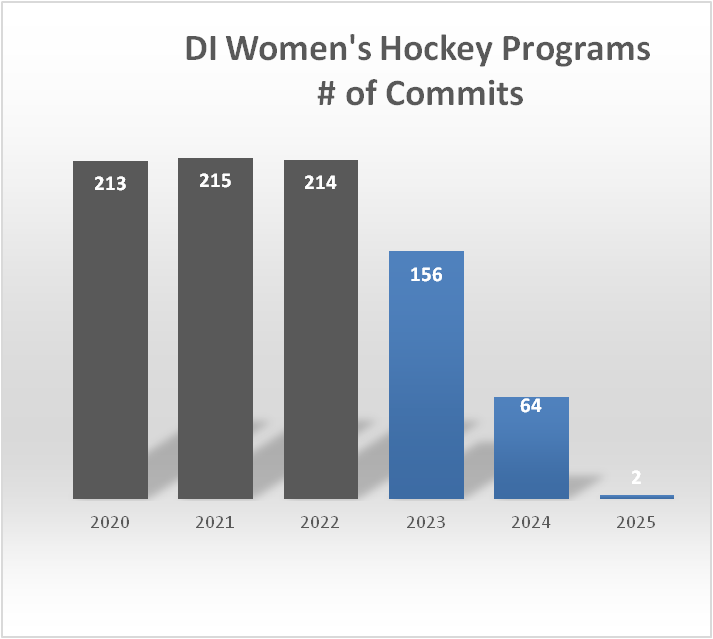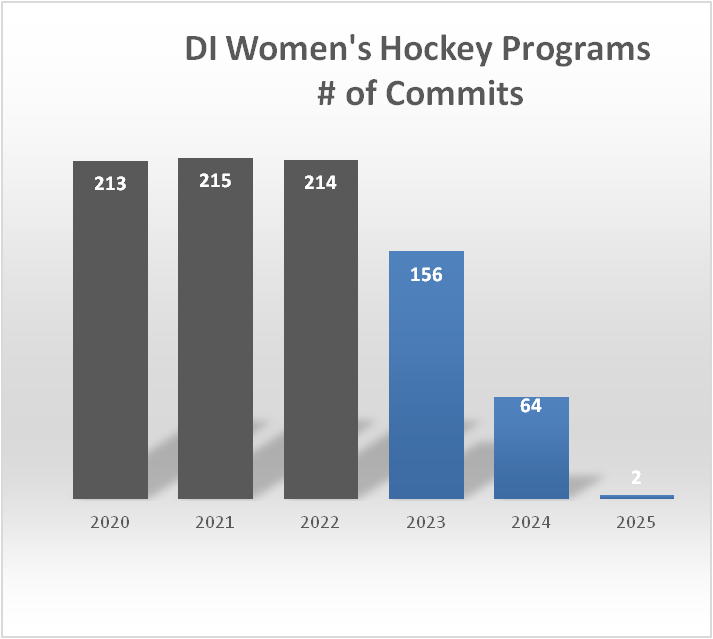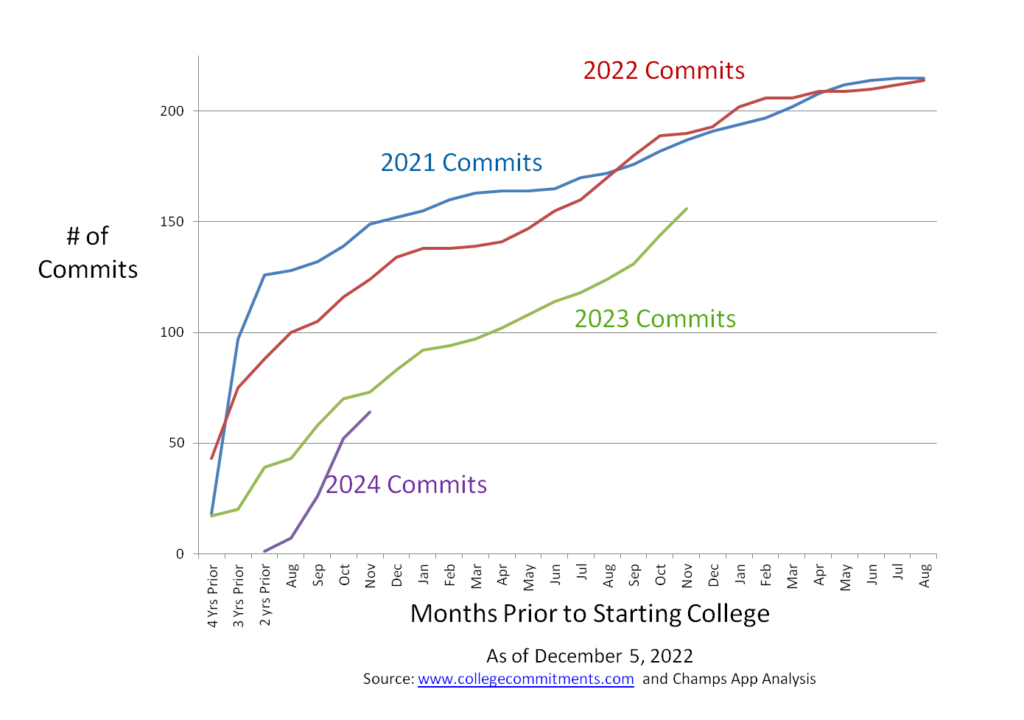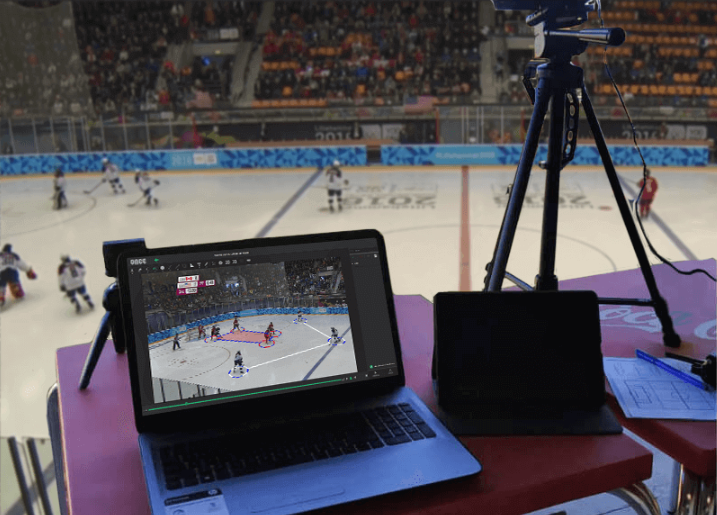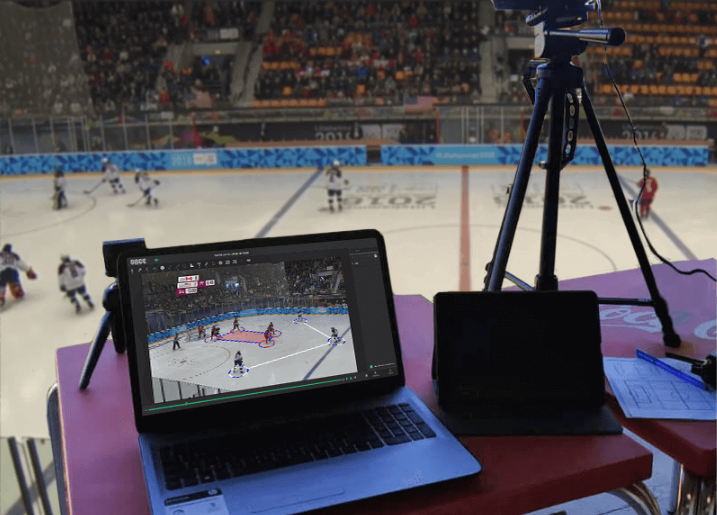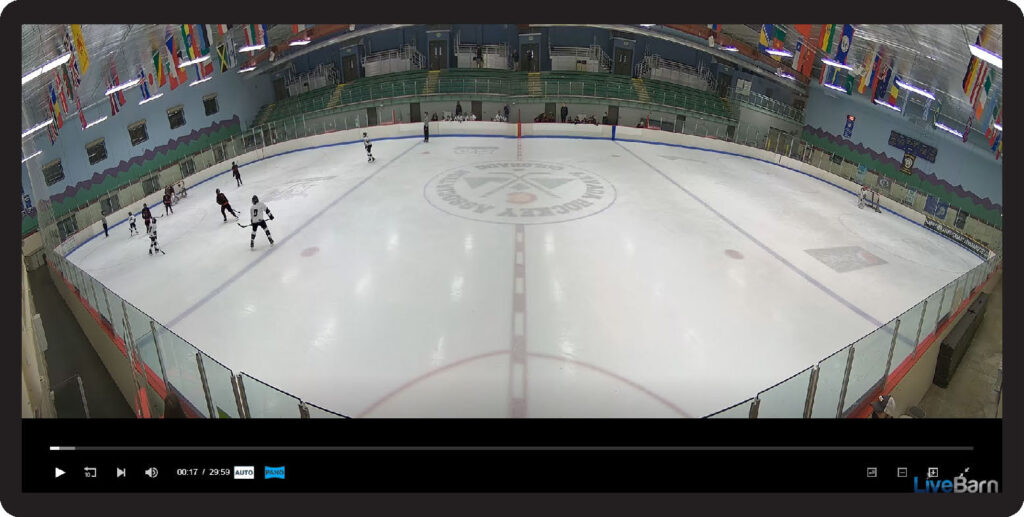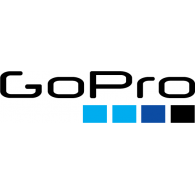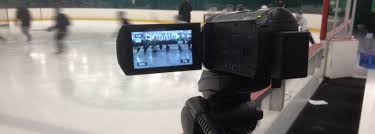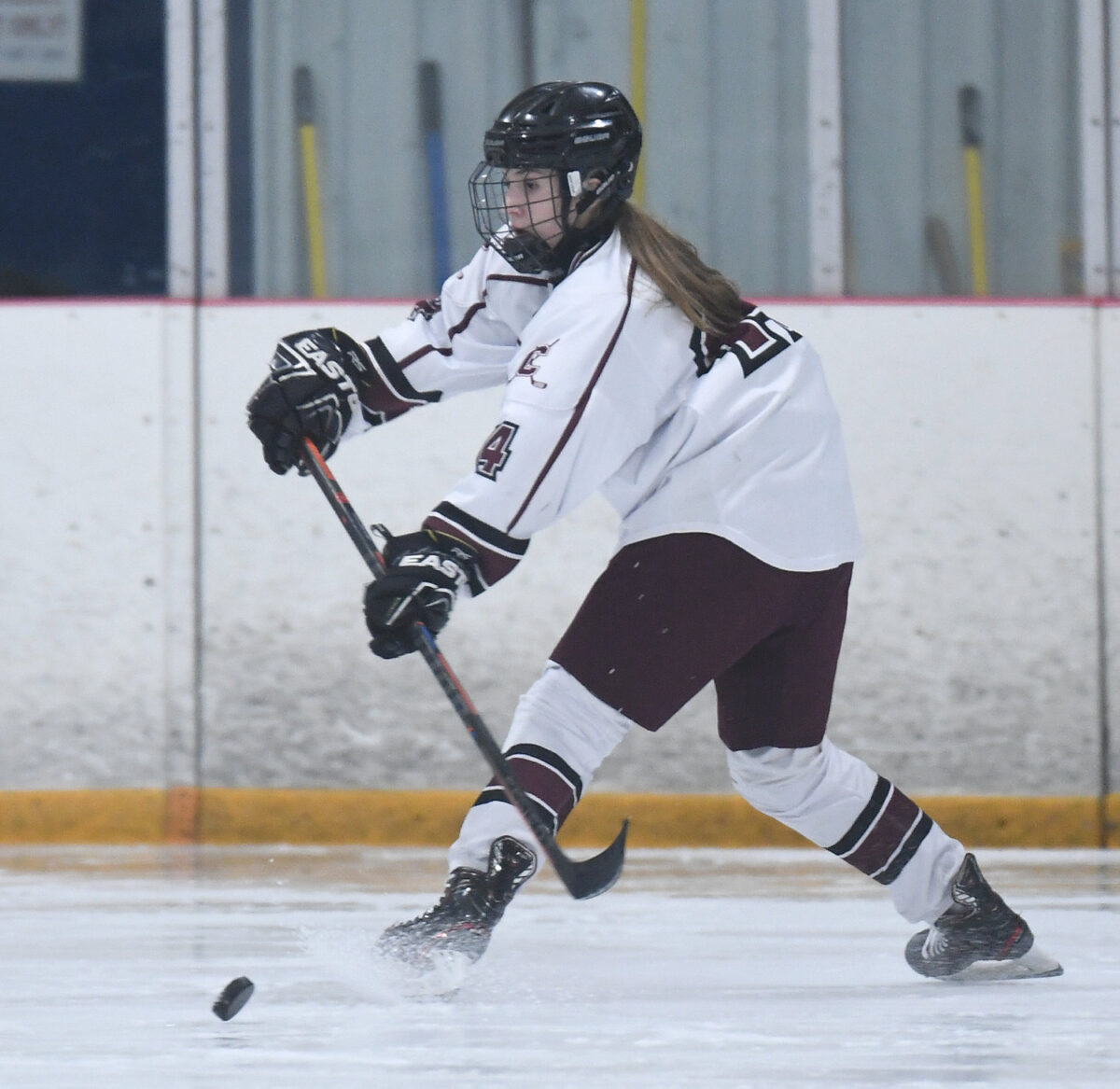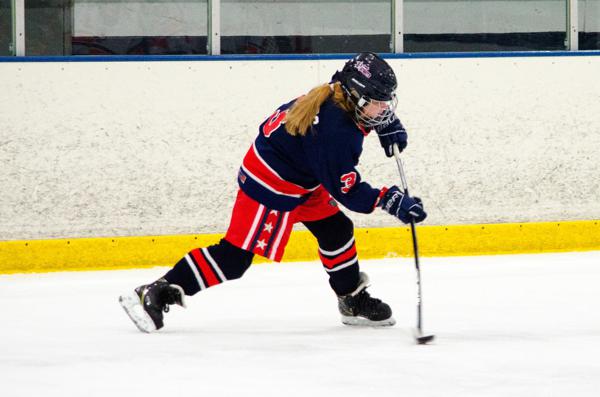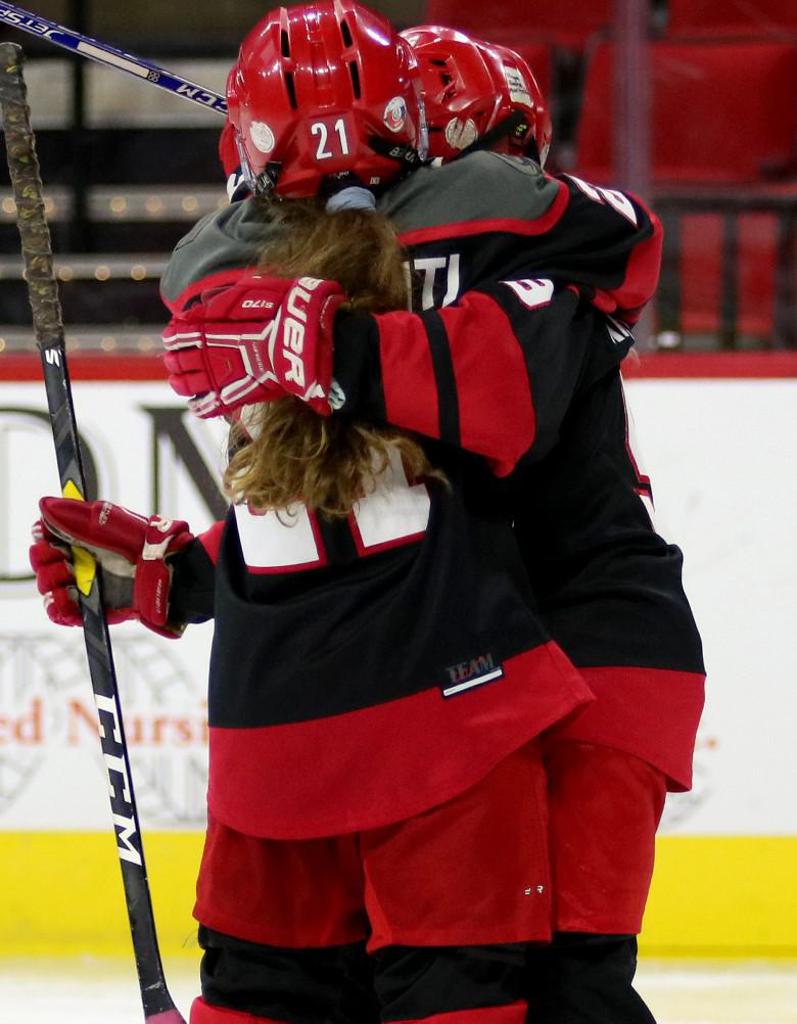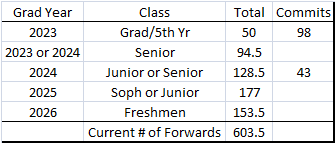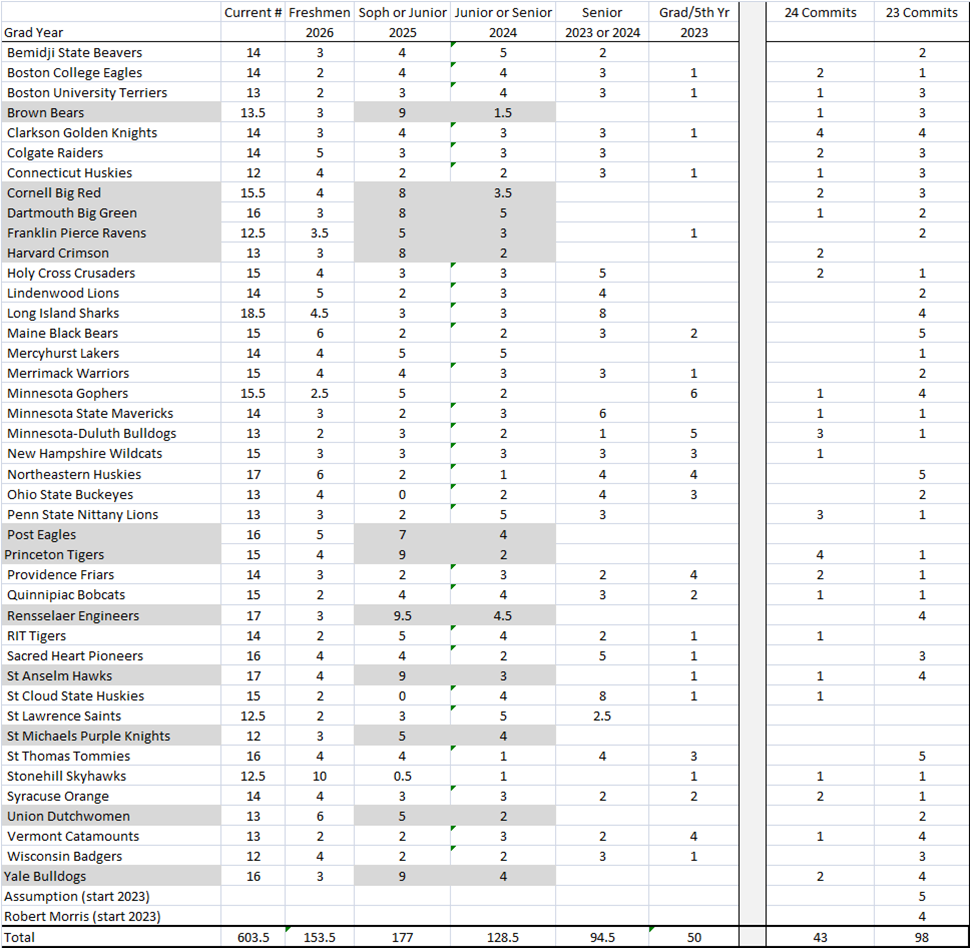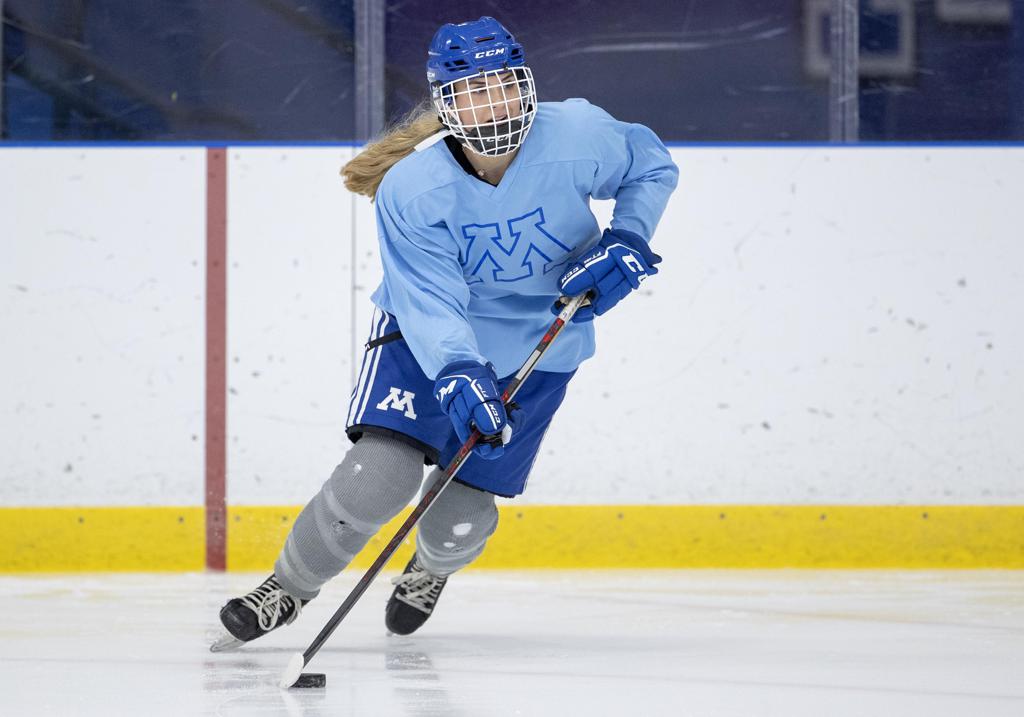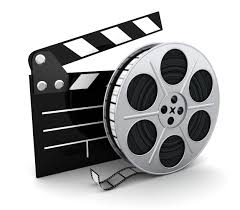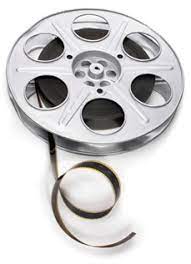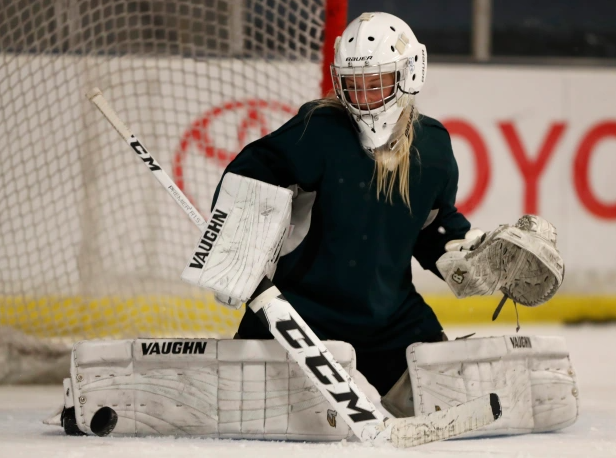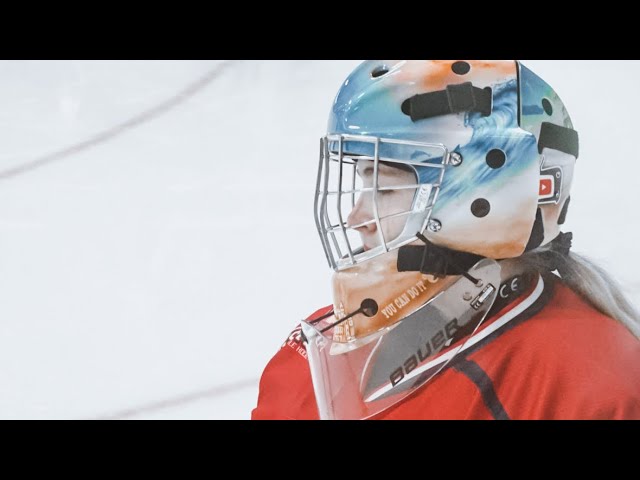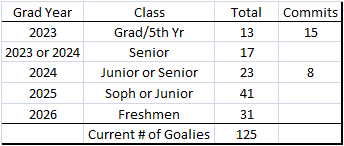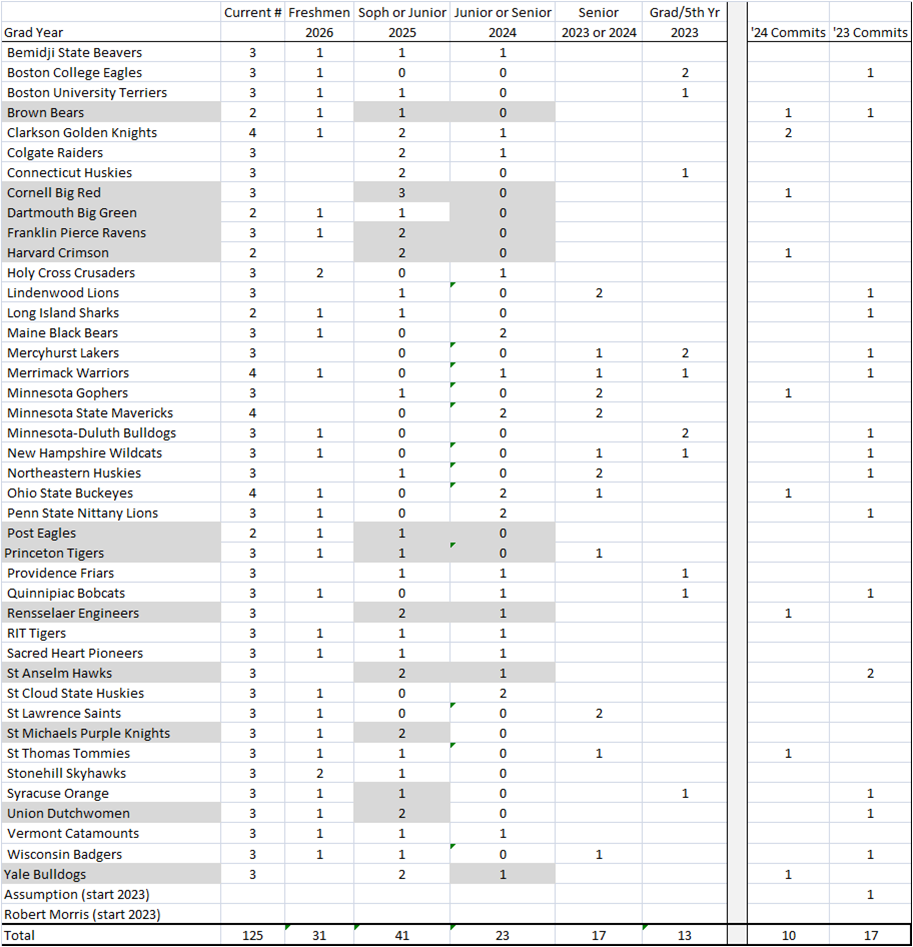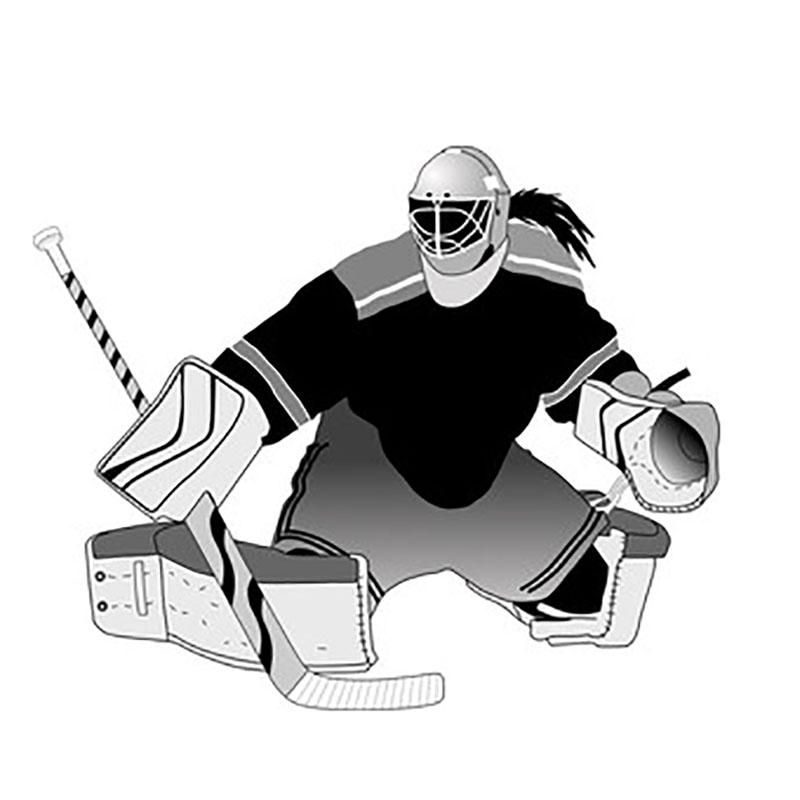| College Hockey Showcases | Spring Break Showcase | April 10-16, 2023 | | Fort Meyers, FL | 2005-2011 Birth Years |
| College Hockey Showcases | St. Louis Showcase | August 4-6, 2023 | Centene Community Ice Arena | St Louis, MO | 2004-2010 Birth Years |
| College Hockey Showcases | Rocky Mountain Showcase | June 16th-18th, 2023 | South Suburban Recreation Complex | Denver, CO | 2005-2011 Birth Years |
| College Hockey Showcases | Sweden Girls High Performance Camp | July 17-28, 2023 | Nyköpings Arenor Rosvalla | Nyköping, Sweden | 2003-2010 Birth Years |
| College Hockey Showcases | Boise Breakaway Showcase | December 15th-17th, 2023 | | Boise, Idaho | 2006-2010 Birth Years |
| NAHA | NAHA COLLEGE SHOWCASE | August 4-6, 2023 | Boston Sports Institute | Wellesley, MA | 2024, '25, '26, '27 Grad Years |
| NCD Camps | GIRLS NCDC COLLEGE DEVELOPMENT CAMP | July 31 - August 2, 2023 | New England Sports Center | Marlborough, MA | 2024, '25, '26, '27 Grad Years |
| Premier Ice Prospects | Hockey Hall of Fame Future Legends | April 27 - 30, 2023 | | Toronto, ON | 2011 Birth Years |
| Premier Ice Prospects | PIPs American Dream | May 5-7, 2023 | American Dream | East Rutherford, NJ | 2009 - 2012 Birth Years |
| Premier Ice Prospects | Premier Prep Prospects | May 11-14, 2023 | The Edge Sports Center | Boston, MA | 2008-2011 Birth Years |
| Premier Ice Prospects | Premier Prospects Boston | May 12-14, 2023 | The Edge Sports Center | Boston, MA | 2008-2009 Birth Years |
| Premier Ice Prospects | Top Prospects | May 19 - 21, 2023 | Hertz Arena | Fort Meyers, FL | 2009 - 2013 Birth Year |
| Premier Ice Prospects | Western Prospects Camp | June 2-4, 2023 | Kraken Community Iceplex | Seattle, WA | 2006-2012 Birth Years |
| Premier Ice Prospects | 585 PIP Showcase | June 16-19, 2023 | Iceplex | Rochester, NY | 2006-2012 Birth Years |
| Premier Ice Prospects | PIPs Tournament | June 23 - 25, 2023 | Iceplex | Rochester, NY | 2009 - 2012 Birth Years Tier I (AAA) |
| Premier Ice Prospects | GIRLS ELITE PROSPECTS CAMP | June 25-29, 2023 | Iceplex | Rochester, NY | 2010 - 2012 Birth Years |
| Premier Ice Prospects | 14U PROSPECTS CAMP | June 25-29, 2023 | Iceplex | Rochester, NY | 2008 Birth Years |
| Premier Ice Prospects | PROSPECTS GOALIE CAMP | June 25-29, 2023 | Iceplex | Rochester, NY | 2007 - 2012 Birth Years |
| Premier Ice Prospects | PREMIER PROSPECTS COMBINE | July 6-9, 2023 | UPMC Sports Complex | Cranberry, PA | 2009 - 2012 Birth Years |
| Premier Ice Prospects | SOUTHERN PROSPECTS CAMP | July 20-23, 2023 | Carolina Ice Palace | North Charleston, SC | 2011 - 2014 Birth Years |
| Premier Ice Prospects | 617 PIP SHOWCASE - BOSTON HARBOR STYLE | July 26-27, 2023 | The Edge Sports Center | Bedford, MA | 2024, '25, '26 Grad Years |
| Premier Ice Prospects | 480 SHOWCASE - DESERT STYLE | August 3-6, 2023 | Mullett Arena | Tempe, AZ | 2006 - 2008 Birth Years |
| Premier Ice Prospects | SOUTHWEST PROSPECTS | August 4-6, 2023 | Mullett Arena | Tempe, AZ | 2009 - 2012 Birth Year |
| Premier Ice Prospects | 615 PIP SHOWCASE - MUSIC CITY STYLE | August 10-13, 2023 | Predators' Ford Ice Center | Bellevue, TN | 2009 - 2010 Birth Years |
| Premier Ice Prospects | NIAGARA FALLS PROPSPECTS CAMP | August 2023 | Gale Centre Arena | Niagara Falls, ON | 2006 - 2010 Birth Years |
| Premier Ice Prospects | Mrs. Hockey® Invite | January 12 - 15, 2024 | | Ft Lauderdale, FL | 12U Girls - Tier 1 & Tier 2 |
| Premier Ice Prospects | Fort Laudy Daudy Showcase | January 12 - 14, 2024 | | Ft Lauderdale, FL | 19U through 14U Tier 1 |
| Premier Ice Prospects | Great Lakes Girls Fest | February 2-4, 2024 | | Detroit, MI | 19U through 10U Tier II |
| Premier Ice Prospects | Motor City Girls Fest | February 2-4, 2024 | | Detroit, MI | 19U through 10U Tier I |
| Premier Ice Prospects | PIPs Rochester | June 23-25 2023 | | Rochester, NY | 2009 thru 2012 Birth Years Tier I (AAA) |
| Premier Ice Prospects | Labor Day Girls Fest | September 1-3 2023 | | Pittsburgh, PA | 14U, 16U/17U and 19U Tier I (AAA)/Canadian AA |
| Premier Ice Prospects | Frieda Falcon Girls Fest | September 8 - 10, 2023 | Slater Family Ice Arena | Bowling Green, OH | 12U USA Tier I / CAN A |
| Premier Ice Prospects | Capital Cup Girls Fest | October 7-9, 2023 | | Northern VA | 19U through 10U Tier II |
| Premier Ice Prospects | Roc City Girls Fest | October 27-29, 2023 | | Rochester, NY | 19U through 10U |
| Premier Ice Prospects | Roc City Girls Fest | November 3-5, 2023 | | Rochester, NY | 19U through 10U Tier I (AAA), Tier II (AA), Tier III (A) |
| Premier Ice Prospects | Burgh Thanksgiving Girls Fest | November 24-26, 2023 | | Pittsburgh, PA | 19U through 10U Tier I (AAA), Tier II (AA), Tier III (A) |
| Premier Ice Prospects | Smashville Girls Fest | November 24-26, 2023 | | Nashville, TN | 19U through 10U Tier I (AAA), Tier II (AA), Tier III (A) |
| Premier Ice Prospects | Erie White Out Weekend | December 8-10, 2023 | | Erie, PA | 12U and 10U Tier I (AAA), Tier II (AA) |
| RUSH Hockey | Florida RUSH | January 13-16, 2023 | Palm Beach Skate Zone | West Palm Beach, FL | Girls Tier 1/Tier 2 (12U, 14U, 16U, 19U) |
| RUSH Hockey | Rush Spring Showcase (Florida) | April 21-23, 2023 | Palm Beach Skate Zone | West Palm Beach, FL | 2024, '25, '26, '27, '28 Grad Years |
| RUSH Hockey | Connecticut Rush | June 9-11, 2023 | Northford Ice Pavilion | Northford, CT | 2009 - 2011 Birth Years |
| RUSH Hockey | Rush College Showcase | June 22-25, 2023 | CAA Centre Brampton | Brampton, ON | 2006 - 2009 Birth Years |
| RUSH Hockey | RUSH RISING STARS PRE-COLLEGE SHOWCASE | June 15-18, 2023 | CAA Centre Brampton | Brampton, ON | 2010 and 2011 Birth Years |
| RUSH Hockey | RUSH ATOMIC CHALLENGE | June 15-18, 2023 | CAA Centre Brampton | Brampton, ON | 2012 and 2013 Birth Years |
| RUSH Hockey | RUSH Hockey High Performance | August 4-6, 2023 | CAA Centre Brampton | Brampton, ON | U11 - U22 AA |
| RUSH Hockey | BEANTOWN CLASSIC | July 21-23, 2023 | New England Sports Center | Marlborough, MA | 2009 - 2013 Birth Years, College / Super Series |
| RUSH Hockey | BEANTOWN CLASSIC | July 28-30, 2023 | New England Sports Center | Marlborough, MA | U19, 2008 |
| RUSH Hockey | BUFFALO RUSH HOCKEY INFERNO | TBD | | Buffalo, NY | Girls Tier 1/Tier 2 (10U, 12U, 14U, 16U, 19U) |
| RUSH Hockey | PHILADELPHIA RUSH | TBD | | Philadelphia, PA | Girls Tier 1/Tier 2 (10U, 12U, 14U, 16U, 19U) |
| RUSH Hockey | NEW ENGLAND RUSH | TBD | | Boston, NA | Girls Tier 1/Tier 2 (12U, 14U, 16U, 19U) |
| RUSH Hockey | NORTH HALTON RUSH | TBD | | North Halton, ON | U11-U18 AA/A/BB/B |
| RUSH Hockey | TWO NATIONS COLLEGE PREP SERIES | TBD | | Brampton, ON & Detroit, MI | 19U through 12U Tier 1; U13-U21 AA |
| Showcase Hockey | 2023 Minnesota Meltdown AAA Tournament | April 21-23, 2023 | | Minnesota | Girls AAA (10U, 12U, 14U, 16U, 19U) |
| Showcase Hockey | 2023 Independent Classic | May 19-21, 2023 | | Minnesota | Girls AAA (8U, 10U, 12U, 14U, 16U, 19U) |
| Showcase Hockey | 2023 AAA Summer Showdown | June 09-11, 2023 | | Minnesota | Girls AAA (10U, 12U, 14U, 16U, 19U) |
| Showcase Hockey | 2023 International Cup | August 4-6, 2023 | | Minnesota | Girls AAA (10U, 12U, 14U, 16U, 19U) |
| Showcase Hockey | 2023 Easton AAA Cup Tournament | August 18-20, 2023 | | Minnesota | Girls AAA (10U, 12U, 14U, 16U, 19U) |
| Showcase Hockey | 2023 Summer Finale | August 25-27, 2023 | | Minnesota | Girls AAA (8U, 10U, 12U, 14U, 16U, 19U) |
| Showcase Hockey | 2023 Warrior Cup AAA | September 8-10, 2023 | | Minnesota | Girls AAA (10U, 12U, 14U, 16U, 19U) |
| 200x85 Tournaments | CCM MLK Girls | Jan 14-16, 2023 | | Massachusetts | 12U - 19U AAA/AA |
| 200x85 Tournaments | CCM CHI-TOWN SHUFFLE | April 21-23, 2023 | | Chicago, IL | Girls Tier 1/Tier 2 (12U, 14U, 16U, 19U) |
| 200x85 Tournaments | CCM GIRLS WORLD INVITE DETROIT | November 10-12, 2023 | | Detroit, MI | Tier 1 – G12U, G14U, G16U, G19U |
| 200x85 Tournaments | CCM GIRLS WINDY CITY ELITE – CHICAGO | December 1-3, 2023 | | Chicago, IL | Tier 1 – G12U, G14U, G16U, G19U |
| 200x85 Tournaments | CCM Girls 68 (14U) | August 10-13, 2023 | | Chicago, IL | 2009 Birthyear |
| The National Girls Hockey League | NGHL NCAA Exposure Camp in York, PA | May 19-21, 2023 | | York, PA | 2004 - 2010 Birth Years |
| The National Girls Hockey League | NGHL NCAA Exposure Camp in Newington, CT | June 10-11, 2023 | | Newington, CT | 2004 - 2010 Birth Years |
| The National Girls Hockey League | Dawg Days of Summer - Red | August 25-27, 2023 | | Northford, CT | 12U-19U |
| The National Girls Hockey League | Dawg Days of Summer - Futures | August 25-27, 2023 | | Newington, CT | 12U |
| The National Girls Hockey League | Labor Day Challenge - Blue | September 2-4, 2023 | | Cromwell, CT | 12U-19U |
| The National Girls Hockey League | Labor Day Challenge - Futures | September 2-4, 2023 | | Cromwell, CT | 12U |
| The National Girls Hockey League | Fall Classic - Red | October 7-9, 2023 | | Syracuse, NY | 14U-19U |
| The National Girls Hockey League | Fall Classic - Futures | October 7-9, 2023 | | Buffalo, NY | 10U & 12U |
| The National Girls Hockey League | NGHL Michigan | November 17-19, 2023 | | Ann Arbor, MI | 14U - 19U Tier 1 |
| The National Girls Hockey League | Mile High Invitational - Blue | November 26-29, 2023 | | Denver, CO | 12U-19U |
| The National Girls Hockey League | MLK Winter Classic - Blue | January 13-15, 2024 | | Haverhill, MA | 12U, 14U, 16U, and 19U |
| The National Girls Hockey League | MLK Winter Classic - Red | January 13-15, 2024 | | Philadelphia, PA | 14-19U Tier 1 |
| The National Girls Hockey League | Red Division Champsionship | February 2-4, 2024 | | Rockland, MA | 14-19U Tier 1 |
| North American Premier Women's Showcase | North American Premier Women's Showcase College Division | June 23-25th, 2023 | Merrimack College Athletics Complex | North Andover, MA | Birth Years 2005-2009 (PG's also Allowed) |
| JWHL | Challenge Cup 2023 | February 17-20, 2023 | | Rockville/Arlington, VA | 14U, 16U, 19U |
| North American Female Elite Showcase | The Orion Top Prospects | June 15-18, 2023 | | Blaine, MN | 2006 - 2011 Birth Years |
| Pony Tail Tournament | Pony Tail Tournament | March 17-19, 2023 | | Baltimore, MD | U10, U12A, U12B, U14A, U14B, U16A, U16B, U19 |
| The Rose Series | Cowgirl Shootout | April 20-23 2023 | | Nashville, TN | 2011 Birth Years |
| The Rose Series | Low Country Classic | May 11-14, 2023 | | Charleston, SC | 2010 Birth Year |
| The Rose Series | The Battle at the Beach | July 6-9, 2023 | | Fort Meyers, FL | 2009 Birth Year |
| The Rose Series | Queens of Vegas | July 11-14, 2023 | | Las Vegas, NV | 2012 Birth Years |
| The Rose Series | OC Freeze Out | July 13-16, 2023 | | Anaheim, CA | 2013 Birth Year |
| The Rose Series | War for the Roses | July 10-15, 2023 | | Edmonton, Alberta | 2010 Birth Year |
| USA Hockey | USA Hockey Girls 15's Player Development Camp | July 10-15, 2023 | Miami University | Oxford, Ohio | 2008 Birth Year |
| USA Hockey | USA Hockey Girls 16/17's Player Development Camp | June 24-30, 2023 | Miami University | Oxford, Ohio | 2006 & 2007 Birth Year |
| USA Hockey | USA Hockey Girls Under 18 Player Development Camp | July 16-22, 2023 | Miami University | Oxford, Ohio | 2006, 2007, 2008 Birth Year |
| USA Hockey | 2023 Women's National Festival | August 7-12, 2023 | | TBD | |
| Colgate University | COLGATE EXPOSURE CAMPS Session 1 | July 17-19, 2023 | Colgate University | Hamilton, NY | 2004-2009 Birth Years |
| Colgate University | COLGATE EXPOSURE CAMPS Session 2 | July 19-21, 2023 | Colgate University | Hamilton, NY | 2004-2009 Birth Years |
| OS Hockey | PROSPECTS/FUTURES WEEKEND 1 Camp | June 2-4, 2023 | Bloomington Ice Gardens | Minneapolis, MN | |
| OS Hockey | PROSPECTS/FUTURES WEEKEND 2 Camp | July 21-23, 2023 | Braemar Arena | MInneapolis, MN | |
| OS Hockey | 2023 OS SPRING FESTIVAL | March 16th-19th, 2023 | Braemar Arena | MInneapolis, MN | |
| OS Hockey | 2023 WHITECAPS CUP (HS) | | | MInneapolis, MN | High School |
| OS Hockey | 2023 TRADITION CUP | August 4th-6th, 2023 | Braemar Arena | MInneapolis, MN | College Level |
| OS Hockey | 2023 OS SHOOTOUT | August 10th-13th, 2023 | Bloomington Ice Garden and Braemar Ice Arena | MInneapolis, MN | U8-U19 |
| Girls Elite Hockey | 2023 TRADITION NIT | October 20-22, 2023 | | Blaine, MN | U16 and U19 |
| University of Wisconsin | 13 and Under Camp | June 26-30, 2023 | LaBahn Arena | Madison, WI | 13 and under |
| University of Wisconsin | High School Elite Camp | August 7-10, 2023 | LaBahn Arena | Madison, WI | High School |
| Princeton University | GIRLS ICE HOCKEY ELITE CAMP | July 7-9, 2023 | Baker Rink | Princeton, NJ | Entering grades 10-12 |
| Princeton University | GIRLS ICE HOCKEY EXPOSURE ID CAMP | July 10-12, 2023 | Baker Rink | Princeton, NJ | Entering grades 7-9 |
| Merrimack College | Merrimack Womens Ice Hockey Clinics | August 18, 2023 | Lawler Arena | North Andover, MA | Entering grades 9-12 |
| RinkSport | RinkSport College Development Camp | June 17-22, 2023 | Babson College | Boston, MA | 2027 High School graduates or earlier |
| Pre-Prep Showcase | Pre-Prep Showcase | August 3rd-6th, 2023 | New England Sports Center | Marlborough, MA | Birth Years: 2008, 2009 & 2010 |
| Ohio State University | YOUTH CAMP | JUNE 19-22, 2023 | OSU Ice Rink | Columbus, OH | U8/U10 and U12 age level |
| Ohio State University | ELITE DAY CAMP | July 15, 2023 | OSU Ice Rink | Columbus, OH | Grad Years: 2025-2027 |
| Ohio State University | HIGH SCHOOL ELITE CAMPS | JUNE 22-23 AND JULY 8-9 | OSU Ice Rink | Columbus, OH | Grad Years: 2025-2027 |
| University of Maine | U16/19 High School Girls' Hockey Camp | July 25-28, 2023 | University of Maine | Orono, ME | Grades 8-12 |
| University of Maine | U8/U10/U12 Girls' Hockey Day Camp | July 25-28, 2023 | University of Maine | Orono, ME | U8/U10/U12 Skaters |
| University of Maine | Women's Prospect Clinic | Monday, July 31 - Tuesday, August 1, 2023 | University of Maine | Orono, ME | Grades 8-12 |
| Brown University | BROWN WOMEN’S HOCKEY ELITE SUMMER CAMP | July 31 - Aug 2, 2023 | Brown University | Providence, RI | High school students entering grades 9-12. Therefore, 2024, 2025, 2026 and 2027 high school graduates. |
| Mercyhurst University | DIVISION I WOMEN'S HOCKEY ELITE CAMP | July 31, 2023 | Mercyhurst University | Erie, PA | 2005 to 2008 birth year |
| Colgate University | 2023 COLGATE EXPOSURE CAMP | PRE-CAMP GOALIE'S ONLY | July 14-16, 2023 | Colgate University | Hamilton, NY | Goalies Only. All Female players born between 2004-2009 |
| Colgate University | 2023 COLGATE EXPOSURE CAMP | SESSION 1 | July 17-19, 2023 | Colgate University | Hamilton, NY | All Female players born between 2004-2009 |
| Colgate University | 2023 COLGATE EXPOSURE CAMP | SESSION 2 | July 19-21, 2023 | Colgate University | Hamilton, NY | All Female players born between 2004-2009 |
| College of the Holy Cross | Holy Cross Women's Ice Hockey Clinics | Aug 29-30, 2023 | Hart Center | Worcester, MA | 14-19 Years Old |
| St Anselm College | | July 17-19, 2023 | Sullivan Arena | Bedford, NH | |
| Clarkson University | Clarkson Golden Knight Women's Hockey Prospect Camp 2023 | Jul 21-22, 2023 | Cheel Campus Center and Arena | Potsdam, NY | 2006-2009 Birth Years |
| St Cloud State University | St. Cloud State Women's Hockey Camps | August 14th - 17th | Herb Brooks National Hockey Center | St. Cloud, Minnesota | Ages 6-16 |
| Quinnipiac University | Quinnipiac Women's Ice Hockey Girls Camp | July 10th-14th, 2023 | M&T Bank Arena | Hamden, Conn | Ages: 6-13 |
| Quinnipiac University | Quinnipiac Women's Ice Hockey Girls Elite Clinic | July 27th, 2023 | M&T Bank Arena | Hamden, Conn | Ages: rising 8th, 9th, 10th, 11th, 12th grade |
| University of Minnesota | MINNESOTA GIRLS HOCKEY CAMPS | June 12-14, 2023 | Mariucci Arena | Minneapolis, MN | 10U &12U Camp |
| University of Minnesota | MINNESOTA GIRLS HOCKEY CAMPS | June 15-16, 2023 | Mariucci Arena | Minneapolis, MN | Exposure Camp (ages 13,14) |
| University of Minnesota | MINNESOTA GIRLS HOCKEY CAMPS | June 19-21 and 21-23, 2023 | Mariucci Arena | Minneapolis, MN | High School/ Varsity Camp #1 & #2 |
| University of Minnesota Duluth | Minnesota Duluth High School Elite Camp | July 26-28, 2023 | Amsoil Arena | Duluth, MN | Any and all high school girls (grad years 2025-2028) are invited |
| College Development Showcase | Girls Camp | June 25-27, 2023 | Ice Den | Hooksett, NH | Players with birth years 2003-2008 |
| Boston College | Maroon and Gold Women’s Combine | August 14-16, 2023 | Conte Forum | Chestnut Hill, MA | 2009-2010-2011 players |
| National Sports Center | All American Girls Hockey Tournament | November 9-12, 2023 | NSC-Super Rink (Blaine) | Blaine, MN | Girls U10A,B U12A,B U15A |
| Youth Hockey Hub | 2023 DANGLEFEST | December 28 - 31, 2023 | NSC-Super Rink (Blaine) | Blaine, MN | Girls U10A, U10B, U12A, U12B, U15A, & U15B |
